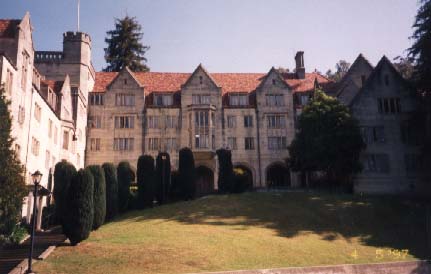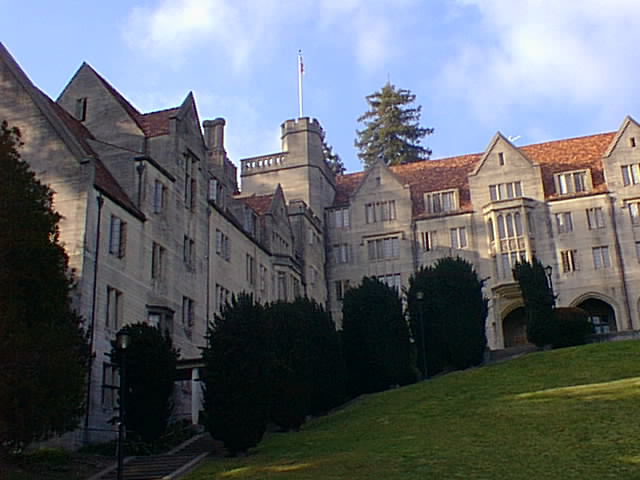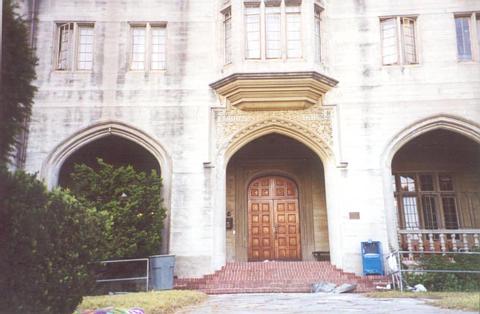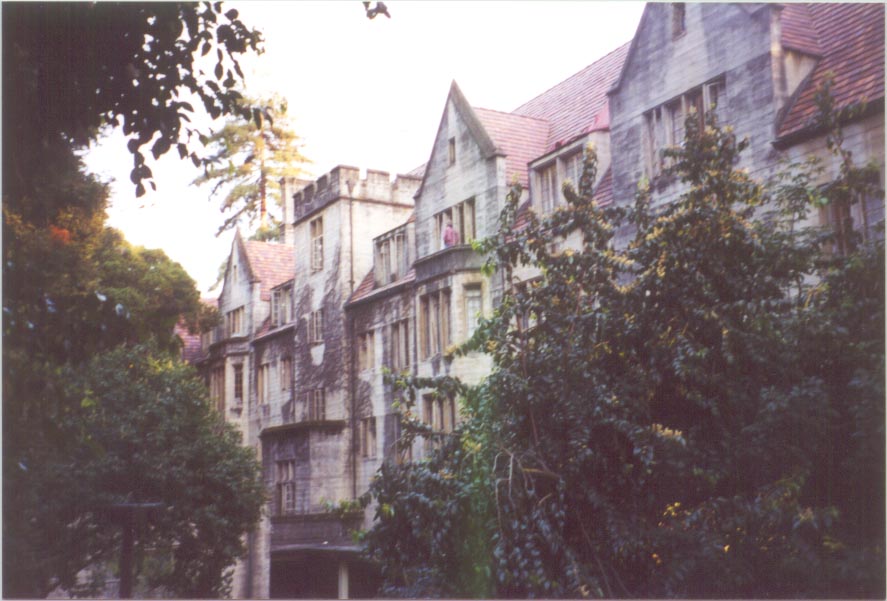|



Castle with a Thousand Tales
(from the 9/16/96 Daily Californian)
All-male Bowles Hall boasts long history of crazy traditions
------------------------------------------------------------------------
By Joe Eskenazi
Daily Cal Staff Writer
"They put me where?"
Such is often the cry of freshmen destined for Bowles Hall upon learning that the slings and arrows of coed living will not be theirs to suffer. But along with the hall's obvious negatives come quite a few positives. Sure, there won't be any "chance" encounters in the coed restroom, but Bowles does come equipped with 68 years of traditions, in varying degrees of filth, lewdness and good old-fashioned nudity.
"I think basically we had the best of both worlds," says UC Berkeley graduate Yas Tana, who lived at Bowles between 1961 and '63. "It was Ivy League without ivy. It was a fraternity without Greek letters. It was a little of everything. We had a broad spectrum of people, and (living in) Bowles brought everyone together."
Built in 1928 as a $350,000 gift from the widow of wealthy banker/Cal grad/former regent Phillip E. Bowles, the hall was designated by the university as California's first state-owned college dormitory.
At the time, UC officials had aims to make Berkeley the "Athens of the West," a lofty goal dropped sometime after the introduction of fiscal responsibility and before the erection of Evans and Wurster halls. In accordance with Athenian desires, architect George Kelham was hired to create a grandiose, historic-looking building.
The result: a medieval fortress better fit to repel an invasion of the Mongol horde than to house students. In addition to its classic facade, Bowles boasts a similarly archaic interior. Students live in partitioned four-man rooms, shower in community facilities and eat in a dining hall straight out of every John Cusack Eastern boarding school movie ever filmed.
Many complain about Bowles' overabundance of Y chromosomes, but the hall's proximity to campus, study-friendly atmosphere and tradition-heavy activities have contributed to a 42 percent return rate -- highest among all the residence halls.
Ever since the first "Bowlesmen" unpacked their bags in January 1929, life at Bowles has been nothing if not quirky. What else can you say about a place where the oldest elected position in the house isn't president or treasurer, but asshole?
"It actually stands for Assistant Social Secretary and Head of Light Entertainment," says former asshole and current Bowles President Brendan Bolles (yes, they're pronounced the same). "It's actually a really hard job."
The asshole's main function is to provide entertainment after weekly hall meetings. Repercussions for failing to produce laughs can actually be quite funny -- but not for the asshole. General unfunniness at a meeting leads to "showering," where the failed jester is bodily thrown into a shower while fully clothed. Showerings after three consecutive meetings means it's high time for an "asshole sandwich."
The unfortunate asshole is then stripped down to his skivvies and lashed in between two mattresses. A procession of Bowlesmen then carry him down to all-female Stern Hall, where he is left on his own for a while to think up funnier material.
A position nearly as old as the asshole -- and no less bizarre -- is "the dork." The dork's job is to hide "the Thing," a small statue resembling the Kahlua mascot that is hailed as Bowles' most sacred object. After the Thing has been hidden, the hall's freshmen spend the year searching for it. Incentive is high to hide the Thing well: when a freshman unearths the Thing, the dork's "traditional punishment" is to be shaved -- from the neck down.
"We've had people climbing to the very top of the roof to hide the Thing in the chimney towers, and we've got a steep, high-peaked roof -- you fall, you're dead," says Bolles, a senior who has lived in the hall for four years. "Every week, the dork posts a clue for the freshmen, and they continue looking for it."
For a place like Bowles, which has a venerated -- though now theoretically dead -- finals week tradition of hurling water-filled projectiles at passers-by, picking up a few rivals along the years was inevitable.
"We always had a lot of competition against the fraternities," says former Bowlesman Dave Benson, who lived at the hall between 1957 and '59. "During Greek Week, we'd always win the chariot races until they didn't let us do it anymore."
While never exactly a bitter rivalry, the contest between Bowles and the frats did occasionally push the boundaries of common decency. Benson recalls an incident in the late 1950s when members of a fraternity stole the hall's pet dog and carved their initials into the poor cur with hair clippers.
In retribution, an enraged Bowlesman took a bulldozer from his job at the Kleeberger Field construction site and drove it up the fraternity's steps a la the Blues Brothers.
"That shook them up a bit," chuckles Benson.
In the mid '60s, Berkeley went through many changes. Bowles also went through a bit of a change, shifting their attention from the frats to mischievous and then-all-male Deutsch Hall.
In 1965, Deutschmen pulled off a major coup. They swiped the Bowles banner and hung it upside-down on Deutsch Hall, a photo-op that made the front page of The Daily Californian.
The Bowlesmen later proved they could give as well as they could get. Phony fliers were distributed around Deutsch, inciting a midnight assault on Bowles Hall. Hundreds of Deutsch residents made the ascent under cover of night, only to be repelled with firehoses and bags of flour by well-entrenched Bowlesmen.
In the last quarter of a century, relations have calmed with the fraternities and out-and-out ended with coed Deutsch. Bowles has found a new opponent though, and, unfortunately for all parties involved, it's UC Housing and Dining Services.
The housing office and Bowles haven't seen eye-to-eye regarding several old Bowles traditions. Below-the-belt shavings and water-bomb projections had to go, of course, as did the "alakazoo," a massive mud battle-royale held on the Bowles front lawn as Wagner's "Ride of the Valkyries" blared on the sound system.
The housing office was most offended by the Bowles "rites of spring," an annual parade of sorts. Screaming Bowlesmen raced around the Campanile five times, through Evans Hall, into Stern Hall and back to Bowles -- all while buck naked.
In 1986 the "rites" were stamped out permanently when the UC Police Department busted the exhibitionists in the act, arresting a few and scattering terrified, naked Bowlesmen across campus.
Whether because of streakers or far more serious and cost-saving reasons, in the late 1980s it was decided that Bowles had outlived its usefulness and would be torn down. Upon hearing the dire news Bowlesman Kenneth Landau sprang into action, writing letters and making arrangements all through the summer of 1989 to place Bowles Hall on the National Register of Historic Places.
Bowles legend has it that on the day UC officials arrived at the hall to inform the residents that after the semester their home would be razed, Landau triumphantly presented them with the certificate designating the hall as a historic place, and therefore untouchable.
"That plaque holds the whole building up," says Bolles. "If that never happened, we wouldn't be here to talk about it. Ken Landau, that's a name for all of us to remember."
So now that we've gotten to know Bowles Hall a little, one may want to introduce himself to the chateau de Bowles. Quick advice: to be part of a hallowed Bowles ritual, simply stand in the hall's courtyard late at night and shout out, "Hello, Bowles Hall!" Quickly enough, you'll receive a cutting reply: "HELLO, ASSHOLE!"
Tradition. Gotta love it.
Copyright 1996, The Daily Californian. All rights reserved.

|  |
Bowles Hall Rich in Tradition
All male dorm different than preconceived notions
By Joshua Bloomekatz
Contributing Writer
For most guys it is not their first choice or even a choice at all, but when guys end up at Bowles Hall, the all-men's dorm, they get a little more than they bargained for.
The traditions and history that are carried on by Bowles residents not only add a little flavor to dorm life but set Bowles apart from the other dorms.
"(I thought) it would be a terrible semester, I'd never see a girl, but while I was here it started changing," says freshman David Smith. "(Now) I'm a fellow Bowlesman, instant connection."
A group of three executive officers and other veteran "Bowlesmen" help to carry on the traditions, which have grown out of the history of Bowles. The three executive positions consist of the Dorque, the A.S.S.H.O.L.E. and the Evil.
These traditions include large events like throwing parties, hiding the spirit of Bowles and smaller things like the weekly bowstimate (ultimate Frisbee) and putting on the weekly comedy night.
"If you contribute to it you'll get a lot out of it," says Boback Ziaeian, a freshman and an executive officer.
One of the most important traditions occurs at Bowles after Hall Association meetings on Tuesday nights, when the resident comedian performs a skit or a comedic routine.
This is the job of the A.S.S.H.O.L.E. (Assistant Social Secretary Head of Live Entertainment) which Ziaeian currently holds.
After Hall Association meetings they kick out all non-Bowles hall members, close the doors, quickly go through any new business and then Ziaeian performs his skit.
Sometimes, 40 to 50 people show up to view these skits, opposed to the 10 people who show up to Hall Association meetings, according to Smith, who is also an executive officer. Oftentimes the skits involve content related to events or people in Bowles itself. Previous skits have included things such as Bowles Hall News and Top 10 lists.
"(Ziaeian's) been funny every time this semester," says Smith.
And what if he isn't funny? There are consequences if he is not funny for three consecutive weeks; it is tradition to give the performer a cold shower in his clothes immediately after the skit as punishment for not being funny.
As an alternative, he can be stripped to his boxers and tied to mattresses and placed in front of Stern, the all-girls dorm.
There is a feeling of connection at Bowles that is not found at some of the larger dorms because of the ongoing traditions. Smith and other residents fear that this connection will be lost next year because returning students are not guaranteed housing in the residence halls.
Bowles has one of the highest returning rates, and approximately 50 percent of the residents want to return. Many students want to return to Bowles not only due to the traditions, but also because of the many single rooms in the hall. Approximately half of the hall consists of single rooms, according to Ziaeian.
But Smith can only think of five students who are returning next year. This is due to the housing shortage and the change in university housing policy in regards to returning students, according to Smith.
Of the more than 2,700 continuing tenants who applied for university housing next semester, only 748 students have received and signed residence hall contracts, according to Eddie Malone, the residence halls coordinator.
Additionally, because only five known students are returning to Bowles next semester, both Ziaeian and Smith worry about how the next Dorque and A.S.S.H.O.L.E. will be selected at the senior dinner this semester.
"Any kind of history or tradition that can be carried on should be," says Smith.
Another tradition, which is still being continued, is the hiding of the spirit of Bowles. This spirit takes the form of a wooden monkey, which is supposed to bring virility without fertility. The Dorque, the regent of this organization, is in charge of hiding the statue.
Every week he gives a clue about the location of the hidden statue. Smith, the current Dorque, was nominated by last semester's Dorque to hide the statue this semester. The previous semester's Dorque now becomes Evil, according to the tradition.
And what if the statue is found? There are punishments for the Dorque as well. He has a choice of three options: He can run around Kleeberger field naked and hitchhike back to the hall, or he can be shaved by the A.S.S.H.O.L.E. from the neck down or he can throw a party.
Other traditions at Bowles include an annual senior dinner in which awards are given for things such as perpetual inurbanity or the Miles Maguozic fire-dancing award for abnormal behavior. At this event the new Dorque and the new A.S.S.H.O.L.E. are selected.
In order to be selected, Bowlesmen have to participate in a contest. The contest for the position of A.S.S.H.O.L.E. is called the A.S.S.H.O.L.E. Olympics. Last semester's contest included eating a pad of butter and taking a shot of ketchup. The last person of the selected Bowlesmen to do this task becomes the A.S.S.H.O.L.E. No Bowlesmen have ever rejected their selection to the position of A.S.S.H.O.L.E.
"There's a lot of pride, I appreciate comedy a lot more than I did," says Ziaeian, who was the last contestant to eat the pad of butter and take a shot of ketchup last semester.
He does admit, however, that while he tries hard there is not any actual reward that comes with the position.
Traditions carried on at Bowles hall are derived from a somewhat interesting history.
For example, the hiding of the statue started when there was another all-men's dorm in Unit One in which the residents would hide it from Bowles residents.
According to Smith, when the dorm was created to make it different from other dorms, the creator had the dorm called a hall instead of a dormitory.
The dorm was only governed by Bowlesmen when it was created, rather than being part of the Residence Hall Association.
Smith also notes the strong connection between Bowlesmen and points out that alumni often return to Bowles during football games.
"When you look at the main lounge, there's so much history," says Smith. "It changes your perspective on what's going on. It's almost a fraternity thing but it's more than that. You are contributing to the tradition."
Comments? Write to opinion@dailycal.org
Copyright 1998, The Daily Californian. All rights reserved.

|



